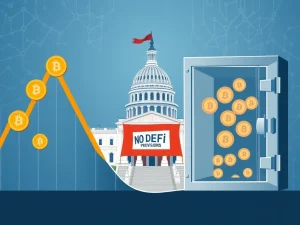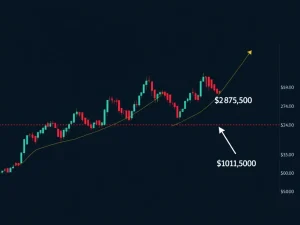Bitcoin Growth: Is the Digital Asset’s Explosive Youth Fading?

Bitcoin, much like any groundbreaking technology, experiences distinct phases. Initially, it burst onto the scene with boundless promise. Now, however, the digital asset faces a pivotal challenge. Its remarkable growth engine, once fueled by explosive gains, shows signs of slowing. This shift suggests a move towards maturity, raising urgent questions for investors and the broader market. Understanding this evolution is crucial for anyone involved in digital asset investment.
The Alarming Trend in Bitcoin Growth Cycles
Early on, Bitcoin captivated the world with its incredible upward trajectory. Nevertheless, a close examination of historical data reveals a concerning pattern. Bitcoin’s exponential growth cycles are dramatically shrinking. This trend signals potential technological maturity limits for the leading cryptocurrency. For instance, the 2013 cycle delivered an astounding 310x growth. This incredible surge captivated early adopters.
However, subsequent cycles show a significant reduction. The 2017 cycle saw growth drop to 143x. By the 2021 cycle, this figure contracted sharply to just 11x. Most recently, the 2025 cycle has seen growth hovering at approximately 2.1x. This geometric decay illustrates an alarming pattern. Each new cycle achieves about a quarter of the previous cycle’s growth. Consequently, this data prompts serious re-evaluation of future expectations for Bitcoin growth.
Academic mathematical statistics further support this observation. Nassim Nicholas Taleb, in his paper ‘Bitcoin, Currencies, and Fragility,’ introduced his “Bubble Model” theory. This model posits that price growth cannot rise indefinitely for a non-yielding asset. Bitcoin, without intrinsic yield, may align with this theory. When an asset becomes primarily “faith-based,” market reality and discipline will eventually pull its momentum downward. Ultimately, the multiplier could dip below 1, transitioning from a growth model to a shrinking model. No economic or speculative run can escape these natural cycles of growth, adjustment, or decline. Therefore, investors must consider whether Bitcoin is approaching a critical inflection point.
Shifting Investor Sentiment and Crypto Market Trends
The evolving landscape of investor sentiment significantly impacts crypto market trends. Recently, an incident involving CleanCore Solutions highlighted this shift. The company’s shares plunged by 60% immediately after it announced plans to pivot into a Dogecoin treasury company. This sharp decline underscores growing investor skepticism. Such skepticism targets speculative crypto ventures, reflecting broader challenges Bitcoin faces. It struggles to maintain momentum amid increasing market volatility.
Moreover, external factors can exacerbate market perception. The infamous ‘Forbes Cover curse,’ often associated with declining fortunes after a prominent feature, may have added to these pressures. Urgent questions about Bitcoin’s longevity, value, and purpose now demand clear answers. Investors are increasingly seeking assets with sustainable models rather than purely speculative plays. This cautious approach marks a maturation of the cryptocurrency investment space. It emphasizes the need for robust fundamentals. Consequently, market participants are scrutinizing projects more thoroughly than ever before. This scrutiny shapes the overall crypto market trends.
The CleanCore example serves as a potent reminder. Unfounded enthusiasm for meme coins or sudden pivots can lead to severe financial repercussions. Investors are becoming savvier. They demand transparency and viable business models. Therefore, the market now punishes purely speculative moves more swiftly. This increased discipline within the market reflects a maturing ecosystem. It signals a move away from the ‘wild west’ days of crypto. This evolution is vital for the long-term health of the industry. It also forces projects to demonstrate genuine utility and sustainable growth strategies.
Decoding Bitcoin Price Analysis: A “Faith-Based” Asset?
The foundation of Bitcoin’s value often sparks intense debate. Joe Lubin, a co-founder of Ethereum, once articulated a vision for Ethereum’s value. He suggested it was based on “faith in the Ethereum blockchain.” In a 2017 interview, Lubin posited that collective belief in cryptocurrency would be sufficient. He argued this factor alone could “snowball into something society deems valuable.” He further suggested this process would be “much like the US dollar.” This view implies money, at its core, relies solely on collective belief and trust. However, this perspective overlooks critical distinctions. These nuances are vital for accurate Bitcoin price analysis.
Fiat currencies, unlike Bitcoin, are supported by comprehensive economic structures. These include monetary policy, taxation, and fiscal measures. Governments can also implement austerity measures or other interventions if they default on debt. Such backing provides intrinsic value and stability. A faith-based asset, by contrast, lacks these foundational supports. Its value derives solely from market demand and collective belief. Fiat currency’s fallback is intrinsic value, backed by the full faith and credit of a government and its productive economy. Bitcoin, despite its revolutionary nature, operates without such governmental guarantees. This fundamental difference is crucial. It informs any comprehensive Bitcoin price analysis. Understanding this distinction helps investors evaluate risk. It also highlights the unique challenges Bitcoin faces as it matures.
Furthermore, the narrative around Bitcoin has evolved. Older narratives portrayed Bitcoin as a hedge against inflation. It was also seen as a protector from government control, particularly in the pre-regulation era. Realities are, however, ever-changing. The increasing integration of Bitcoin into traditional finance through ETFs means it operates within existing regulatory frameworks. This integration changes its role. It moves from an outsider challenger to a recognized, albeit volatile, asset class. This shift impacts its perceived value and future trajectory. Therefore, a nuanced approach to Bitcoin price analysis is essential. It must consider both market sentiment and underlying economic realities.
The Evolution: From Bitcoin Product to Blockchain Technology Infrastructure
Longevity in technology often depends on foundational elements. What truly stands the test of time is typically not the product itself, but the infrastructure that supports it. For example, MySpace and Netscape once dominated their respective fields. They eventually faded away. However, the underlying infrastructure, like the internet, has endured and evolved. This principle applies profoundly to the cryptocurrency space. Bitcoin began as a revolutionary product. It was designed to challenge the traditional financial system. Its meteoric rise attracted millions, promising financial freedom. Yet, like any technology product, it faces natural limits. Even blockchain, the underlying technology, relies on cryptographic principles. Understanding this distinction is key for long-term investment strategies.
In contrast, blockchain technology infrastructure refers to the physical and operational components. These components ensure blockchain networks function reliably and at scale. This infrastructure includes several critical elements. Network nodes, encompassing full and validator nodes, form the backbone. The network protocol defines how these nodes communicate and validate transactions. Data storage systems maintain and support the entire ecosystem. These foundational elements enable the creation and operation of various blockchain-based products and services. They represent the enduring value in the ecosystem. Focusing on this infrastructure offers a more stable long-term outlook. It shifts the perspective from a single asset to the broader technological foundation.
This strategic pivot is becoming increasingly relevant. As Bitcoin navigates its midlife phase, the focus naturally shifts. The underlying blockchain technology provides a more robust investment thesis. It offers a broader utility beyond just a single digital currency. Infrastructure development is crucial for scalability, security, and interoperability. These factors are essential for the continued growth of the entire crypto industry. Investors who understand this distinction can make more informed decisions. They can identify opportunities that offer sustained value. This perspective helps move beyond short-term market fluctuations. It instead emphasizes the foundational elements driving innovation.
Navigating Digital Asset Investment in a Maturing Market
Bitcoin has reached a pivotal crossroads, akin to a midlife crisis. Its acceptance by institutions and the emergence of ETFs represent a significant milestone. These developments are comparable to a technology’s graduation into a more established role. However, Bitcoin’s waning volatility also provides crucial insights. This reduced volatility, once a hallmark of explosive early growth, now hints at maturity. It might even signal a period of contraction. For those engaged in digital asset investment, recognizing this trend is paramount. It necessitates a re-evaluation of traditional strategies.
Astute investors, often referred to as ‘OG investors,’ have already begun adapting. Many have divested from Bitcoin. Instead, they reinvest in newer, more dynamic tokens like Ethereum. Others have shifted their focus entirely toward infrastructure projects. This long-term strategy prioritizes foundational technology. Both trends, importantly, point to Bitcoin’s evolving future. They suggest a market moving beyond singular asset speculation. Instead, it embraces broader technological advancements. This transition underscores a fundamental truth in technology. Individual technologies, no matter how revolutionary, ultimately have finite lifespans. Durable infrastructure, however, often outlives its product counterparts. Therefore, strategic digital asset investment demands a forward-looking approach.
The implications for future digital asset investment are profound. As the market matures, opportunities may shift. They could move from high-risk, high-reward speculative plays to more stable, utility-driven investments. Investors must diversify their portfolios. They should consider assets that contribute to the underlying blockchain ecosystem. This includes protocols, decentralized applications, and layer-2 solutions. Furthermore, understanding market cycles and technological lifespans becomes critical. This knowledge enables investors to anticipate shifts. It helps them position themselves for sustainable returns. Thus, adapting to this maturing market is not just an option. It is a necessity for long-term success in digital asset investment.
The Imperative of a Lifecycle Perspective for Bitcoin Growth
A lifecycle perspective is absolutely essential for navigating Bitcoin’s current phase. Just as individuals recognize their own aging through receding hairlines or increasing waistlines, so too must investors acknowledge the maturation of technology. Every technology has a life cycle; Bitcoin is no exception. It remains subject to immutable laws of lifecycle dynamics. While Bitcoin experiences bear and bull runs, the underlying Bitcoin growth cycle has begun to shrink. This trend necessitates a re-evaluation of expectations and strategies. Understanding this natural progression is vital for making informed decisions. It guides the industry towards its next evolution.
For investors, innovators, and policymakers, this perspective is invaluable. It helps in understanding the broader crypto market trends. For instance, before committing to a Bitcoin treasury plan with a 20-year lockup period, consider a simple analogy. Do you own any electronic devices from 41 years ago? Were you even born 41 years ago? Bitcoin, as a technology, originated with its genesis block in 2009. It will be 41 years old when those hypothetical locked-up tokens become fully accessible. This thought experiment highlights the long-term nature of such commitments. It also emphasizes the rapid pace of technological change.
Reflecting on Bitcoin’s lifecycle will be vital for making informed, strategic decisions. This rapidly evolving world demands foresight. It also requires adaptability. The crypto ecosystem is dynamic. It continually introduces new technologies and investment opportunities. Therefore, maintaining a lifecycle perspective allows for proactive adjustments. It helps mitigate risks associated with technological obsolescence. It also identifies emerging areas of growth. This thoughtful approach ensures sustainable engagement within the digital asset space. It ultimately contributes to more resilient investment portfolios and a more robust industry future.
Opinion by: Joshua Chu, co-chair of the Hong Kong Web3 Association. This article is for general information purposes and is not intended to be and should not be taken as legal or investment advice. The views, thoughts, and opinions expressed here are the author’s alone and do not necessarily reflect or represent the views and opinions of Crypto News Insights.









